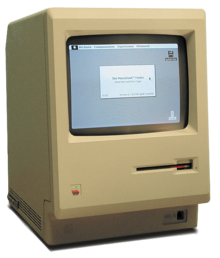1981–1985: Lisa and Macintosh
1981–1985: Lisa and Macintosh

Steve Jobs began working on the Apple Lisa in 1978 but in 1982 he was pushed from the Lisa team due to infighting, and took over Jef Raskin's low-cost-computer project, the Macintosh. A turf war broke out between Lisa's "corporate shirts" and Jobs' "pirates" over which product would ship first and save Apple. Lisa won the race in 1983 and became the first personal computer sold to the public with a GUI, but was a commercial failure due to its high price tag and limited software titles.[36]

In 1984, Apple next launched the Macintosh. Its debut was announced by the now famous $1.5 million television commercial "1984". It was directed by Ridley Scott, aired during the third quarter of Super Bowl XVIII on January 22, 1984,[37] and is now considered a watershed event for Apple's success[38] and a "masterpiece".[39][40]
The Macintosh initially sold well, but follow-up sales were not strong[41] due to its high price and limited range of software titles. The machine's fortunes changed with the introduction of the LaserWriter, the first PostScript laser printer to be offered at a reasonable price point, and PageMaker, an early desktop publishing package. The Mac was particularly powerful in this market due to its advanced graphics capabilities, which were already necessarily built-in to create the intuitive Macintosh GUI. It has been suggested that the combination of these three products was responsible for the creation of the desktop publishing market.[42]
In 1985, a power struggle developed between Jobs and CEO John Sculley, who had been hired two years prior.[43] The Apple board of directors instructed Sculley to "contain" Jobs and limit his ability to launch expensive forays into untested products. Rather than submit to Sculley's direction, Jobs attempted to oust him from his leadership role at Apple. Sculley found out that Jobs had been attempting to organize a putsch and called a board meeting at which Apple's board of directors sided with Sculley and removed Jobs from his managerial duties.[41] Jobs resigned from Apple and founded NeXT Inc. the same year [44]